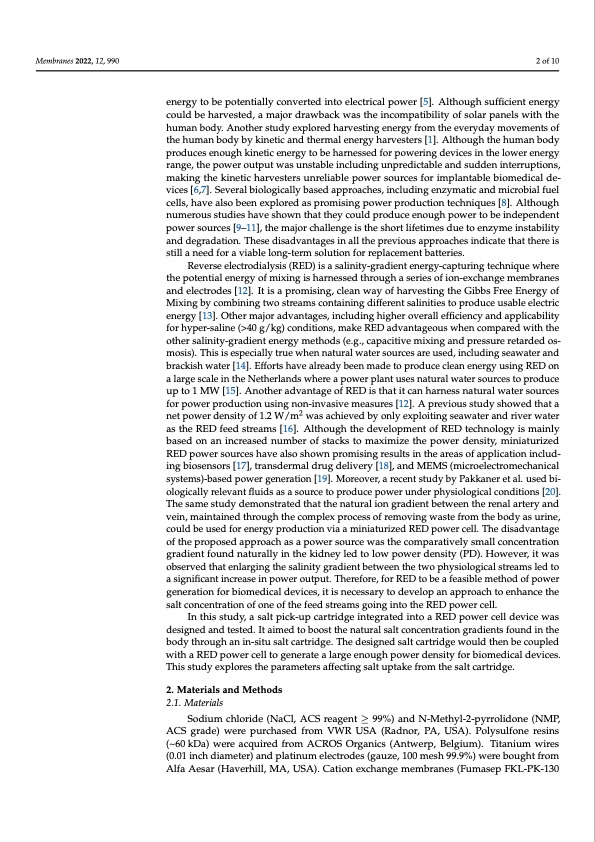
PDF Publication Title:
Text from PDF Page: 002
Membranes 2022, 12, 990 2 of 10 energy to be potentially converted into electrical power [5]. Although sufficient energy could be harvested, a major drawback was the incompatibility of solar panels with the human body. Another study explored harvesting energy from the everyday movements of the human body by kinetic and thermal energy harvesters [1]. Although the human body produces enough kinetic energy to be harnessed for powering devices in the lower energy range, the power output was unstable including unpredictable and sudden interruptions, making the kinetic harvesters unreliable power sources for implantable biomedical de- vices [6,7]. Several biologically based approaches, including enzymatic and microbial fuel cells, have also been explored as promising power production techniques [8]. Although numerous studies have shown that they could produce enough power to be independent power sources [9–11], the major challenge is the short lifetimes due to enzyme instability and degradation. These disadvantages in all the previous approaches indicate that there is still a need for a viable long-term solution for replacement batteries. Reverse electrodialysis (RED) is a salinity-gradient energy-capturing technique where the potential energy of mixing is harnessed through a series of ion-exchange membranes and electrodes [12]. It is a promising, clean way of harvesting the Gibbs Free Energy of Mixing by combining two streams containing different salinities to produce usable electric energy [13]. Other major advantages, including higher overall efficiency and applicability for hyper-saline (>40 g/kg) conditions, make RED advantageous when compared with the other salinity-gradient energy methods (e.g., capacitive mixing and pressure retarded os- mosis). This is especially true when natural water sources are used, including seawater and brackish water [14]. Efforts have already been made to produce clean energy using RED on a large scale in the Netherlands where a power plant uses natural water sources to produce up to 1 MW [15]. Another advantage of RED is that it can harness natural water sources for power production using non-invasive measures [12]. A previous study showed that a net power density of 1.2 W/m2 was achieved by only exploiting seawater and river water as the RED feed streams [16]. Although the development of RED technology is mainly based on an increased number of stacks to maximize the power density, miniaturized RED power sources have also shown promising results in the areas of application includ- ing biosensors [17], transdermal drug delivery [18], and MEMS (microelectromechanical systems)-based power generation [19]. Moreover, a recent study by Pakkaner et al. used bi- ologically relevant fluids as a source to produce power under physiological conditions [20]. The same study demonstrated that the natural ion gradient between the renal artery and vein, maintained through the complex process of removing waste from the body as urine, could be used for energy production via a miniaturized RED power cell. The disadvantage of the proposed approach as a power source was the comparatively small concentration gradient found naturally in the kidney led to low power density (PD). However, it was observed that enlarging the salinity gradient between the two physiological streams led to a significant increase in power output. Therefore, for RED to be a feasible method of power generation for biomedical devices, it is necessary to develop an approach to enhance the salt concentration of one of the feed streams going into the RED power cell. In this study, a salt pick-up cartridge integrated into a RED power cell device was designed and tested. It aimed to boost the natural salt concentration gradients found in the body through an in-situ salt cartridge. The designed salt cartridge would then be coupled with a RED power cell to generate a large enough power density for biomedical devices. This study explores the parameters affecting salt uptake from the salt cartridge. 2. Materials and Methods 2.1. Materials Sodium chloride (NaCl, ACS reagent ≥ 99%) and N-Methyl-2-pyrrolidone (NMP, ACS grade) were purchased from VWR USA (Radnor, PA, USA). Polysulfone resins (~60 kDa) were acquired from ACROS Organics (Antwerp, Belgium). Titanium wires (0.01 inch diameter) and platinum electrodes (gauze, 100 mesh 99.9%) were bought from Alfa Aesar (Haverhill, MA, USA). Cation exchange membranes (Fumasep FKL-PK-130PDF Image | Integrated Salt Cartridge-Reverse Electrodialysis

PDF Search Title:
Integrated Salt Cartridge-Reverse ElectrodialysisOriginal File Name Searched:
membranes-12-00990.pdfDIY PDF Search: Google It | Yahoo | Bing
Product and Development Focus for Salgenx
Redox Flow Battery Technology: With the advent of the new USA tax credits for producing and selling batteries ($35/kW) we are focussing on a simple flow battery using shipping containers as the modular electrolyte storage units with tax credits up to $140,000 per system. Our main focus is on the salt battery. This battery can be used for both thermal and electrical storage applications. We call it the Cogeneration Battery or Cogen Battery. One project is converting salt (brine) based water conditioners to simultaneously produce power. In addition, there are many opportunities to extract Lithium from brine (salt lakes, groundwater, and producer water).Salt water or brine are huge sources for lithium. Most of the worlds lithium is acquired from a brine source. It's even in seawater in a low concentration. Brine is also a byproduct of huge powerplants, which can now use that as an electrolyte and a huge flow battery (which allows storage at the source).We welcome any business and equipment inquiries, as well as licensing our flow battery manufacturing.| CONTACT TEL: 608-238-6001 Email: greg@salgenx.com | RSS | AMP |